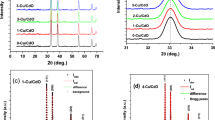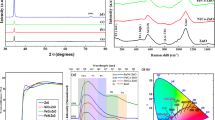Abstract
Inbuilt high energy band gap and resistivity cause harm to the intrinsic molybdenum trioxide (MoO3) for utilizing it directly in gas sensing and optoelectronic devices. Doping with transition metal ions can be an optimistic solution to these problems. By doping four side of modification of a material is possible. At first, doping can curtail the width of the energy band of semiconductor materials, thereby largely boosting the photo-sensitivity of the material and intensifying the light consumption that is more suitable for anti-laser devices and light source substances. The second is that doping can widen the material's band gap, which can significantly reduce the purities of the substance, improve absorbance, and make it suitable for strong interference semiconductor films and aperture materials. Third, changing the material's charge carrier density and effective mass can significantly improve conductivity. This is mostly relevant for conductive devices and photosensitive materials. Finally, changing the material's valance electron location influences the magnetic moment created by the spin of elementary particles in the entire system, allowing the magnetic characteristics of the substance to be regulated, which is especially useful for diluted magnetic semiconductor (DMS) materials. The investigation report of the structural, electrical, and optical characteristics of Cobalt (Co)-doped orthorhombic-phase MoO3 utilizing plane-wave pseudo-potential technique based on first-principles computation is presented in this paper. The computation has been executed using density a functional theory (DFT)-based CASTEP computer program with the generalized gradient approximation (GGA) together with the Perdue-Burke-Ernzerhof (PBE) exchange–correlation function. Acquired structural parameters present good consistency with the former reported experimental data. The resultant electronic band structure reveals that pure MoO3 shows an indirect energy band gap of 1.873 eV/2.312 eV whereas Co doping causes band narrowing of about 0.94 eV/1.36 eV with PBE/HSE techniques. The total and partial density of states (PDOS) have been studied comparatively, for pure and Co-doped MoO3, respectively. The absorption coefficient, loss function, reflectivity, refractive index, extinction coefficient, dielectric function, along with optical conductivity have also been determined to analyze the optical properties of Co-doped MoO3. Co-doped MoO3 offers higher conductivity while decreasing resistivity, compared to the undoped case. The present study ensures that Co-doped α- MoO3 can be competently employed as a functional material in gas sensing and optoelectronic devices.







Similar content being viewed by others
Data availability
The data and code that support the findings of this study are available from the corresponding author upon reasonable request.
References
M D Haque, M H Ali, M F Rahman and A Z M T Islam Opt. Mater. 131 112678 (2022)
M H Ali, M A Al Mamun, M D Haque, M F Rahman, M K Hossain and A Z M Touhidul Islam ACS Omega 8 7017 (2023)
N Rahman, M D Haque, M F Rahman, M M Islam, M A N Juthi, A R Roy, M A Akter and M F Islam Discov. Mater. 3 (2023)
B Sultana, A T M S Islam, M D Haque, A Kuddus, M H Ali and M F Rahman Phys. Scripta 98 (2023)
F Paquin, J Rivnay, A Salleo, N Stingelin and C Silva J. Mater. Chem. C 3 10715 (2015)
K Galatsis, Y X Li, W Wlodarski, E Comini, G Sberveglieri, C Cantalini, S Santucci and M Passacantando Sens. Actuators B Chem. 83 276 (2002)
N R Dighore, S P Jadhav, S T Gaikwad and A S Rajbhoj Int. J. Eng. Res. Appl. 4 135 (2014)
S Bhatia and A Khanna Struct. Opt. Prop. Molybd. Trioxide Thin Films p 080057 (2015)
H-J Lunk et al. Inorg. Chem. 49 9400 (2010)
R Pandeeswari and B G Jeyaprakash Biosens. Bioelectron. 53 182 (2014)
K Kalantar-zadeh et al. Nanoscale 2 429 (2010)
Z Su, L Wang, Y Li, G Zhang, H Zhao, H Yang, Y Ma, B Chu and W Li ACS Appl. Mater. Interfaces 5 12847 (2013)
N Illyaskutty, S Sreedhar, G Sanal Kumar, H Kohler, M Schwotzer, C Natzeck and V P M Pillai Nanoscale 6 13882 (2014)
K Galatsis, Y Li, W Wlodarski and K Kalantar-zadeh Sens. Actuators B Chem. 77 478 (2001)
A K Prasad, P I Gouma, D J Kubinski, J H Visser, R E Soltis and P J Schmitz Thin Solid Films 436 46 (2003)
S Balendhran et al. ACS Nano 7 9753 (2013)
B Y Zhang et al. Adv. Funct. Mater. 28 1706006 (2018)
J K Shon et al. Nat. Commun. 7 11049 (2016)
R Sivakumar, M Jayachandran and C Sanjeeviraja Surf. Eng. 20 385 (2004)
C Bechinger, S Ferrere, A Zaban, J Sprague and B A Gregg Nature 383 608 (1996)
Z Yin, X Zhang, Y Cai, J Chen, J I Wong, Y-Y Tay, J Chai, J Wu, Z Zeng, B Zheng, H Y Yang and H Zhang Angew. Chemie Int. Ed. (2014)
J N Yao, K Hashimoto and A Fujishima Nature 355 624 (1992)
Y B Li, Y Bando, D Golberg and K Kurashima Appl. Phys. Lett. 81 5048 (2002)
Y Chen, C Lu, L Xu, Y Ma, W Hou and J-J Zhu CrystEngComm 12 3740 (2010)
J Zhou, S Z Deng, N S Xu, J Chen and J C She Appl. Phys. Lett. 83 2653 (2003)
L Cheng, M Shao, X Wang and H Hu Chem. Eur. J. 15 2310 (2009)
R S Datta, F Haque, M Mohiuddin, B J Carey, N Syed, A Zavabeti, B Zhang, H Khan, K J Berean, J Z Ou, N Mahmood, T Daeneke and K Kalantar-zadeh J. Mater. Chem. A 5 24223 (2017)
M Arita, H Kaji, T Fujii and Y Takahashi Thin Solid Films 520 4762 (2012)
T Brezesinski, J Wang, S H Tolbert and B Dunn Nat. Mater. 9 146 (2010)
R Liang, H Cao and D Qian Chem. Commun. 47 10305 (2011)
M T Greiner, L Chai, M G Helander, W-M Tang and Z-H Lu Adv. Funct. Mater. 23 215 (2013)
S Bandaru, G Saranya, N J English, C Yam and M Chen Sci. Rep. 8 10144 (2018)
Y Zhao, J Liu, Y Zhou, Z Zhang, Y Xu, H Naramoto and S Yamamoto J. Phys. Condens. Matter 15 L547 (2003)
L Zheng, Y Xu, D Jin and Y Xie Chem. Mater. 21 5681 (2009)
C V. Subba Reddy, E H Walker, S A Wicker, Q L Williams and R R Kalluru J. Solid State Electrochem. 13 1945 (2009)
A Michailovski and G R Patzke Chem. Eur. J. 12 9122 (2006)
M H Kim et al. Nano Lett. 9 4138 (2009)
V Nirupama and S Uthanna J. Mater. Sci. Mater. Electron. 21 45 (2010)
M F Al-Kuhaili, S M A Durrani, I A Bakhtiari and A M Al-Shukri Opt. Commun. 283 2857 (2010)
I Navas, R Vinodkumar, K J Lethy, A P Detty, V Ganesan, V Sathe and V P Mahadevan Pillai J. Phys. D Appl. Phys. 42 175305 (2009)
S S Mahajan, S H Mujawar, P S Shinde, A I Inamdar and P S Patil Appl. Surf. Sci. 254 5895 (2008)
A Hojabri, F Hajakbari and A E Meibodi J. Theor. Appl. Phys. 9 67 (2015)
P-R Huang, Y He, C Cao and Z-H Lu Sci. Rep. 4 7131 (2014)
Q Meng, L Fan, L Zhu, N Xu and Q Zhang Int. J. Quantum Chem. 118 e25681 (2018)
Q Qu, W-B Zhang, K Huang and H-M Chen Comput. Mater. Sci. 130 242 (2017)
S J Clark, M D Segall, C J Pickard, P J Hasnip, M I J Probert, K Refson and M C Payne Zeitschrift Fur Kristallographie 220 567 (2005)
M K Hossain, A A Arnab, R C Das, K M Hossain, M H K Rubel, M F Rahman, H Bencherif, M E Emetere, M K A Mohammed and R Pandey RSC Adv. 12 34850 (2022)
M K Hossain, M H K Rubel, G F I Toki, I Alam, M F Rahman and H Bencherif ACS Omega 7 43210 (2022)
J P Perdew, K Burke and M Ernzerhof Phys. Rev. Lett. 77 3865 (1996)
H Sitepu Powder Diffr. 24 315 (2009)
M F Rahman, M Harun-Or-Rashid, M R Islam, A Ghosh, M K Hossain, S Bhattarai, R Pandey, J Madan, M A Ali and A B M Ismail Phys. Scripta 98 (2023)
A Ghosh, M F Rahman, M R Islam, M S Islam, M Hossain, S Bhattarai, R panday, J Madan, M A Rahman and A B Ismail Opt. Continuum 2 (2023)
M F Rahman, M A I Islam, M R Islam, M H Ali, P Barman, M A Rahman, M Harun‐Or‐Rashid, M Hasan and M K Hossain Nano Select 4 (2023)
A B Shanto,M F Rahman, R Islam, A Ghosh, A Azzouz-rached, H Albalawi and Q Mahmood F1000Research 12 (2023)
F Rahman, A Rahman, R Islam, A Ghosh, A B Shanto, M Chowdhury, A I Islam, H Rahman, M K Hossain and M A Islam AIP Adv. 085329 1 (2023)
A Ghosh, F Rahman, R Islam and S Islam Heliyon 9 e19271 (2023)
M F Rahman, H Rahman, R Islam and M K Hossain J. Mater. Sci. 58 (2023)
M F Rahman, M M Islam, M R Islam, A Ghosh, M A Rahman, M H Rahman, M A I Islam, M A Islam, H Albalawi and Q Mahmood J. Solid State Chem. 328 124341 (2023)
D G Hinks, B Dabrowski, J D Jorgensen, A W Mitchell, D R Richards, S Pei and D Shi Nature 333 836 (1988)
T Nishio, J Ahmad and H Uwe Phys. Rev. Lett. 95 176403 (2005)
C M I Okoye Eur. Phys. J. B 39 5 (2004)
A Rahman, A Rahman and Z Rahaman J. Adv. Phys. 5 354 (2016)
A B Kuzmenko Rev. Sci. Instrum. 76 083108 (2005)
Z Xu Solid State Commun. 76 1143 (1990)
L Lajaunie, F Boucher, R Dessapt and P Moreau Phys. Rev. B 88 115141 (2013)
M K Hossain et al. Sci. Rep. 1 (2023)
R Islam, M F Rahman, S Bhattarai, H Bencherif, M K A Mohammed, R Pandey and J Madan Energy & Fuels 37 (2023)
Acknowledgements
The authors are satisfied to Department of Electrical and Electronic Engineering Begum Rokeya University, Rangpur 5400, Bangladesh due to using Advanced Energy Materials and Solar Cell Research Laboratory.
Funding
By getting no specific grants, this research was done from funding agencies in the non-profit sectors including public and marketable.
Author information
Authors and Affiliations
Contributions
MFR, MHA: Conceptualization, Methodology, Software, Validation, Formal analysis, Visualization, Investigation, Data Curation, Supervision, Writing-Original Draft, Review & Editing. ZRM, AG: Methodology, Software, Validation, Formal analysis, Visualization Investigation, Data Curation, Writing-Original Draft, Review & Editing. PB, MRI, MKH: Methodology, Software, Validation, Formal analysis, Writing-Original Draft, Review & Editing.
Corresponding authors
Ethics declarations
Conflict of interest
The all authors have no conflicts of interest.
Ethical approval
The all authors declare that the manuscript does not have studies on human subjects, human data or tissue, or animals.
Additional information
Publisher's Note
Springer Nature remains neutral with regard to jurisdictional claims in published maps and institutional affiliations.
Rights and permissions
Springer Nature or its licensor (e.g. a society or other partner) holds exclusive rights to this article under a publishing agreement with the author(s) or other rightsholder(s); author self-archiving of the accepted manuscript version of this article is solely governed by the terms of such publishing agreement and applicable law.
About this article
Cite this article
Rahman, M.F., Melody, Z.R., Ali, M.H. et al. First-principles analysis of how Cobalt doping affects the structural, electronic, and optical properties of α-MoO3. Indian J Phys (2023). https://doi.org/10.1007/s12648-023-03043-w
Received:
Accepted:
Published:
DOI: https://doi.org/10.1007/s12648-023-03043-w




